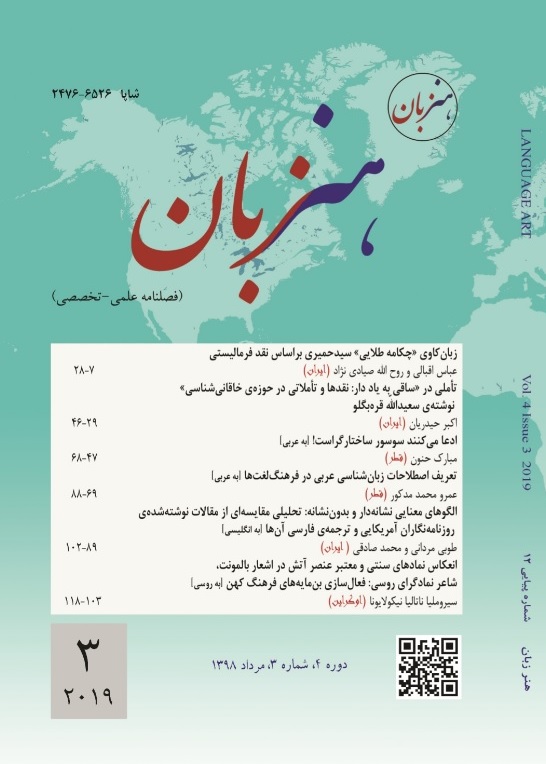الگوهای معنایی نشانهدار و بدوننشانه: تحلیلی مقایسهای از مقالات نوشتهشدهی روزنامهنگاران آمریکایی و ترجمهی فارسی آنها
DOI::
https://doi.org/10.22046/LA.2019.17کلمات کلیدی:
الگوهای معنایی، زمینههای نشانهدار، زمینههای بدوننشانه، آغازگر و پایانبخش، دستور زبان نقشگرای نظاممند.چکیده
الگوهای معنایی فرایند مرتبکردن الگوهای آغازگری و پایانبخشی در یک متن بهشمار میروند. الگوهای معنایی عمل یا فرایند ذهنی انتخاب موضوعاتی خاص بهعنوان آغازگر در گفتمان یا کلماتی بهعنوان آغازگر در جملات درنظر گرفته میشوند. هدف از تحقیق جاری پیبردن به این موضوع بود که مترجمان چگونه به سازماندهی زمینههای خود بهصورت نشانهدار و بدوننشانه میپردازند و اینکه این سازماندهیها چه ارتباطی با متن اصلی دارد. این مقاله به بررسی راهکارهای معنایی در مقالات انگلیسی میپردازد و آنها را با ترجمهی فارسی آنها مقایسه مینماید. بهاین منظور، نیویورک تایمز، یکی از روزنامههای پیشرو در ایالات متحدهی آمریکا، انتخاب گردید. متون استخراجشده به یک مترجم حرفهای برای ترجمه ارائه گردید و سپس یک ارزیاب متخصص آن را ارزیابی نمود. براساس تجزیهوتحلیلهای کمیوکیفی و ویژگیهای متنی و زمینههای نشانهدار و بدوننشانه شش مقاله و ترجمهی فارسی آنها انتخاب شد. یافتهها حاکی از آن است که الگوهای معنایی میتوانند به مترجمان در انتقال بهتر پیام در زبان هدف کمک کنند. نتایج مربوط به الگوهای معنایی نشانهدار و بدوننشانه در متون اصلی و ترجمهی آنها نسبتاً مشابه بوده است.مراجع
Alonso B. I. & McCabe, A. (1998). Theme-rheme patterns in L2 writing. Didactica (Lenguay Literatureura), 10, 13-31.
Baker, M. (1992). In other words. London and New York: Routledge
Barzegar, H. (2008). Differences between marked and unmarked translation of English thematized sentences regarding their effect on the audience. Retrieved January 2, 2011, from http://www.translationdirectory.com/articles/article 1592.php.
Bell, Roger T. (1991). Translation and translating. Theory and practice. New York: Longman Inc.
Bloor, T., & Bloor, M. (1995). The functional analysis of English: A Hallidayan approach. London: Arnold.
Brown, G. and Yule G. (1983). Discourse analysis. Cambridge: Cambridge University Press.
Butt, D., Fahey, R., Feez, S, et al. (2003). Using functional grammar-- An explorer’s guide. Sydney: National Centre for English Language Teaching and Research.
Caldas-Coulthard. (1996). Texts and Practices: Readings in critical discourse analysis. London: Routledge.
Catford, J.C. (1965). A linguistic theory of translation. London: Oxford University Press.
Davison, A.: 1980, ‘Any As Existential or Universal?’, in J. van der Auwera (ed.),The Semantics of Determiners (Croom Helm, London), pp. 11–40.
Eggins, S. (1994). An introduction to systemic functional linguistics. London: Pinter.
Fairclough, N. (1989). Language and power. London: Longman.
Fairclough, N (1995). Critical discourse analysis: The critical study of language. London and New York. Longman.
Fang, Jing, et all. (2008). What may be Hidden behind a Translator's Choice: A comparative analysis of two translations of The Art of War. In systemic functional linguistics in use, OWPLC Vol: 29 pp 283-306. Retrieved August 10th, 2012 from http://static.sdu.dk/media files.
Fowler, R. (1991). Languages in the News: discourse and ideology in the press. London. Routledge.
Gosden, H. (1992). Discourse functions of marked theme in scientific research articles. Journal of English for Specific Purposes, 11, 207-224.
Grzegorek, M. (1984). Thematizatiion in English and Polish: Poznan.
Hall, S. (1982). The rediscovery of ideology: Return of the repressed in media studies. In James Curran et al (eds.). Culture, Society, and the Media (pp. 56-90). London: Methuen.
Halliday, M.A.K. (1970). New Horizons in Linguistics. Harmondsworth: Penguin Books.
Halliday, M.A.K. (1985). An introduction to functional grammar. London: Edward Arnold.
Halliday, M.A.K. (1994). An introduction to functional grammar. New York: Edward Arnold.
Halliday, M.A.K., & Matthiessen, Ch. M. L. M. (2004). An introduction to functional grammar. London: Arnold Publisher.
Hasselgard, H. (2004). Thematic choice in English and Norwegian. Functions of Language, 11.2, 187-212.
Hatim, B., & Mason, I. (1990). Discourse and the translator. London: Longman.
Hodge, R. & Kress, G. (1993). Language as ideology (2nd ed.). London: Routledge.
Jallilifar, A. (2009). Thematic development in English and translated academic texts. Retrieved January 3, 2011, from Journal of Language & Translation 10(1), 81-111.
Jallilifar, A. R. (2010). The status of theme in applied linguistics articles. Retrieved January 2, 2011, from http://www.Asian-esp-journal.com
Jallilifar, A.R. & Khedri, M. (2011). Thematic development in English and translated academic text. In A.R. Jalilifar & E. Abdollahzadah (Eds.), Academic research genre in Asian context (pp. 335-364). Ahwaz: Shahid Chamran University Press.
Larson, M.L. (1984). Meaning-based translation: A guide to cross-language equivalence. Lanham: University Press of America.
Lotfipour-Saedi, K. (1991). Analyzing Literary Discourse: Implication for Literary Translation. Paper presented at Tabriz University Conference on Translation, Tabriz.
Matthiessen, C. (2004). Descriptive motifs and generalizations, in Caffarel, A., Martin, J. R. & Matthiessen, C. (eds.). Language functional perspective, Amsterdam: John Benjamins, pp. 537-673.
McCabe, A. (1999). Theme and Thematic Patterns in Spanish and English History Text (PhD Dissertation). Aston: Aston University.
Newmark, P. (1988). A textbook of translation: Prentice Hall International (UK) Ltd.
Prince, E. F. (1981). Toward a taxonomy of given-new information. Radical Pragmatics, (ed) Cole, P. New York: Academic Press. 223-255.
Thompson, G. (2004). Introducing functional grammar. 2nd ed. London: Arnold.
Wang, Xuefeng. (2009). Grammatical concepts and their application in foreign language teaching. Retrieved November 19th, 2011. http://www.aare.edu.au/06pap/wan06111.pdf. Academic research genre in Asian context (pp. 335-364). Ahwaz: Shahid Chamran University Press.
Van Dijk, T. A. (1988). News analysis: Case studies of international and national news in the press. Hillsdale. NJ: Lawerence Erlbaum.
Van Dijk, T. A. (1991). Racism and the press. London: Routledge.
Van Dijk, T. A. (1993). Analyzing racism through discourse analysis. Some methodological reflections. In: J. Stanfield (ed.). Race and ethnicity in Research Methods. (pp. 92-134). Newbury Park, CA: Sage.
Ventola, E. (1995).Thematic development and translation. In M. Ghadessy (Ed.). Thematic development in English text (pp.85-104) London: Pinter.
Yarmohammadi, L. (1995). Textual analysis of English and Persian written texts in contrast and its possible pedagogical implications. In Fifteen articles in contrastive linguistics and the structure of Persian. Tehran Publication (pp. 101-115).
Zhou, YA. (2006). The interpersonal metafunction and theme in English and Chinese advertisement texts. Retrieved April 5, 2009, from http://www.linguist.org.cn/doc/uc200605/uc20060511.pdf

